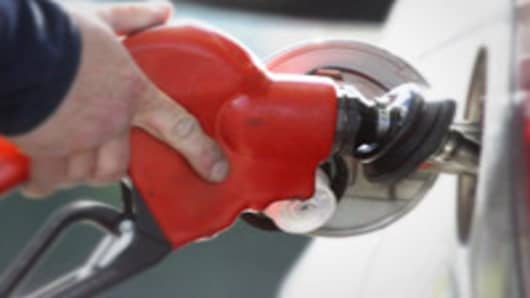Though they have finally begun using less gasoline, US consumers remain pretty much powerless to contain prices at the pump.
The Energy Information Administration released new numbers Wednesday that confirm Americans have been consuming less gas since the shocking runup of prices to more than $4 a gallon for regular unleaded. That should be good news that translates at the pump to a break from $4.10 gas.
But because their counterparts in developing countries across the globe continue to fill their tanks at will, often with gas priced artificially low because of government subsidies, there's likely to be little relief on the way.
"Unfortunately drivers are not going to be hugely rewarded for cutting back, at least not in the short term," said Andrew Gordon, investment director of Investor's Daily Edge. "That's the unfortunate thing. The market shouldn't proceed in that way, but we're in a global market and not a domestic market."
Indeed, the EIA's report, rather than providing hope for lower energy prices, instead merely drove home a reminder that even though the US is the world's largest consumer of oil, demand in the US is now only one element in an array of factors controlling the cost of gasoline and oil.
"We could easily have a scenario where as much as Americans conserve on oil here, consumers in very far away places like India and China are consuming more than we are saving, which would make supplies tighter, which would drive prices up," Gordon added. "That's a scenario which has in fact been at work over the last several months."
The EIA reported that gasoline stocks showed an unexpected rise of 900,000 barrels last week, confounding analyst expectations that reserves actually would drop 200,000 barrels. Energy experts interpreted the swell in supply directly to conservation efforts.
But foreign demand continues to accelerate even though growth in emerging markets like Brazil and India has slowed. And pressure remains on oil prices because of artificial inflators in countries including Saudi Arabia and Venezuela, where government subsidies keep gas at a bargain-basement 75 cents a gallon.
In the meantime, rising energy prices are squeezing the US economy, which also is beset with falling housing prices and rising unemployment.
"It's one more nail in the coffin for the consumer," said Tom Higgins, chief economist at Los Angeles-based Payden & Riegel. "None of it bodes well for the American consumer. Once the impact of this fiscal stimulus fades at the end of the third quarter there are significant risks for the decline of consumer spending, and therefore the decline of GDP growth as we head to year's end."
Oil Could be Headed Lower
Higgins sees both oil and gas coming off their record highs but still settling at relatively big numbers--oil around $100 a barrel and gas still above $3 a gallon.
"Economic growth has slowed globally," he said. "In that environment you wouldn't anticipate that oil prices are going to be sustained. I would anticipate that oil prices fall back below $100 a barrel at some point. I just don't know what point--later in 2008 or in 2009."
That may be too late to help the flagging US economy from heading into a technical recession.
"We may now be getting to a tipping point where commodities break the real economy, and that's what we have to worry about," Mohamed El-Erian, co-CEO of Pimco, the manager of the largest bond fund in the US, said on CNBC.
Another factor in the inability of Americans to control their own gas prices is their weak currency, which makes dollar-denominated oil a more attractive buy on the world market.
The Federal Reserve can help lower gas prices by bolstering the dollar through aggressive monetary policy, said Gordon, of Investor's Daily Edge.
"Historically there's not a huge correlation between the dollar and the price of oil (but) it has been much more tightly correlated over the past few months, and I think that is going to continue into the immediate future," Gordon said. "So I think it's important over the next few months if the Fed does stay on message and the dollar does strengthen ... that will have an impact on lowering prices."
"But at some point the fundamentals of supply and demand have to get with the program," he said.
Like Higgins, Gordon expects oil to fall later in the year, to as low as $115 a barrel, and some are even more bearish about the price.
David Goerz, chief investment officer at Highmark Capital, told CNBC he envisions oil falling to as low as $60 a barrel in the long term, and $100 this year.
"We are concerned about the triple threat of conservation, substitution and innovation," he said, "and we think that the longer-term issues are going to come into play now and that ultimately we have to get back to an equilibrium of $60 to $70."
Mark Solazzo, president of M. Solazzo Trading, sees a short-term drop to $130 from the $137 level oil was at Wednesday afternoon.
But relief for the consumer will be slow in coming as world demand continues to spread.
"Demand in the US isn't the primary driver behind prices. It's really global consumption," Gordon said. "Longer-term, if US consumers do change their patterns of consumption and you do have some slowing down of growth in Asia, US consumers can be rewarded for conserving."


